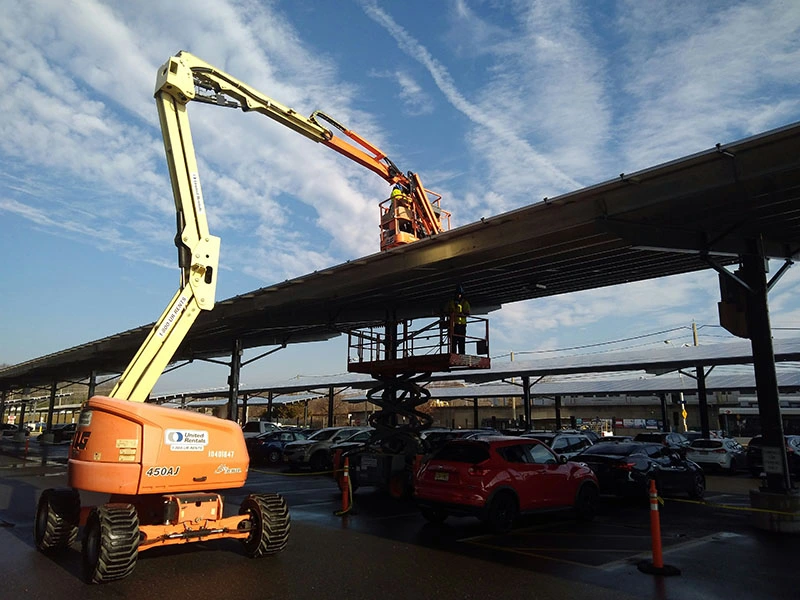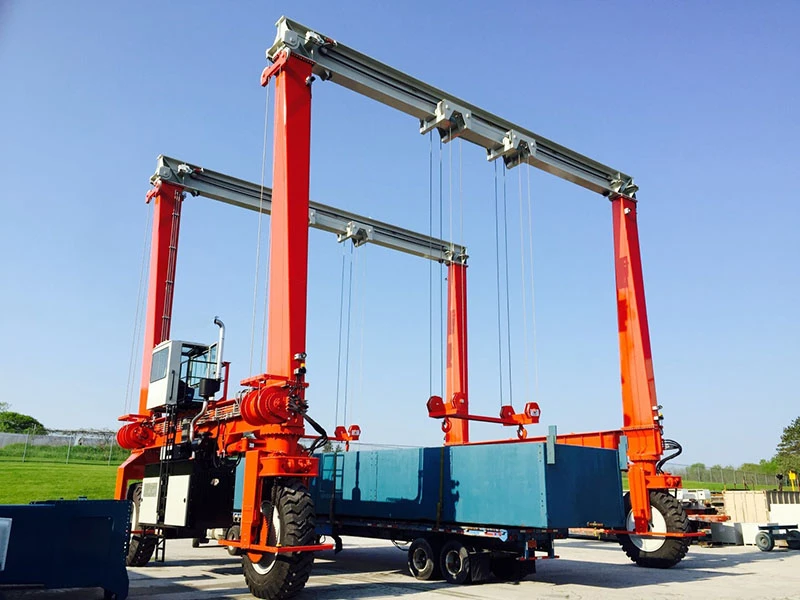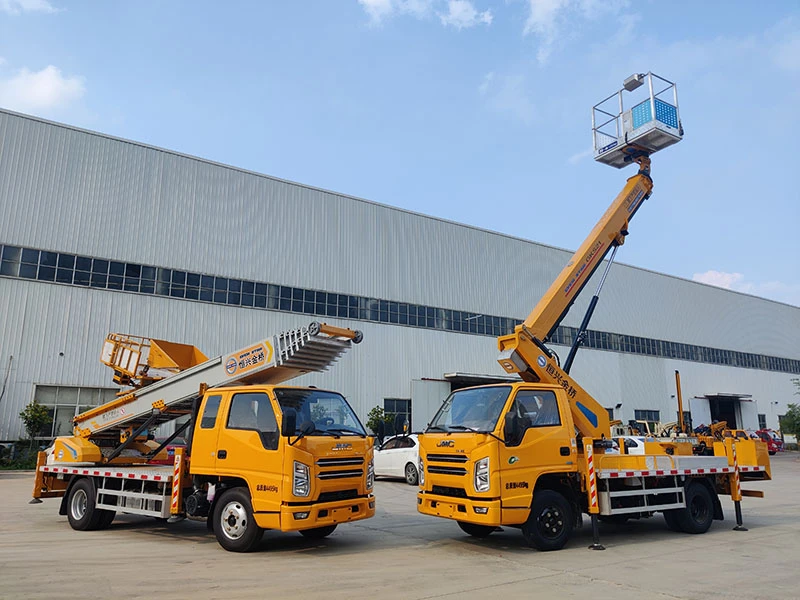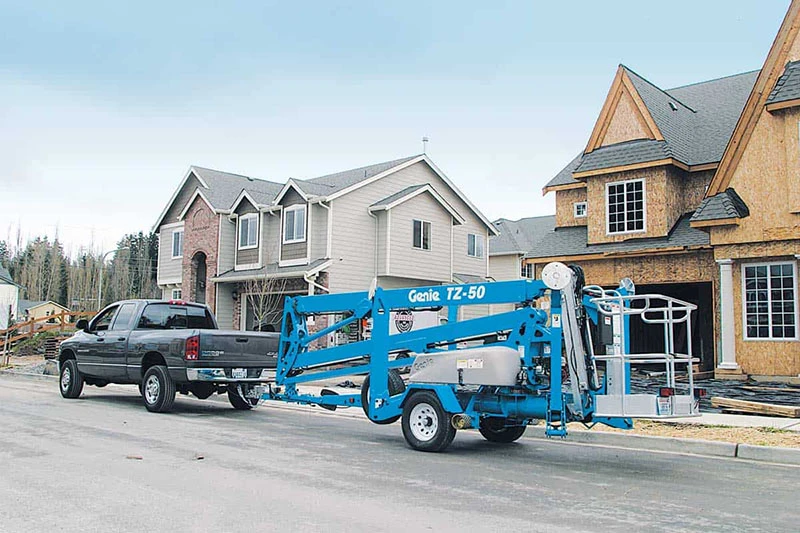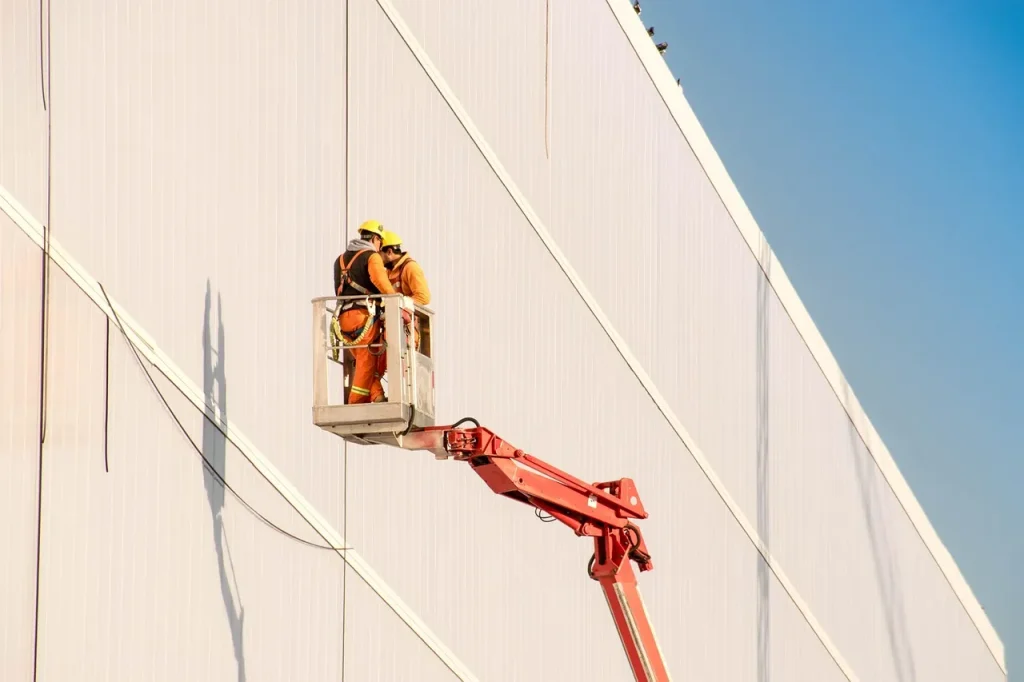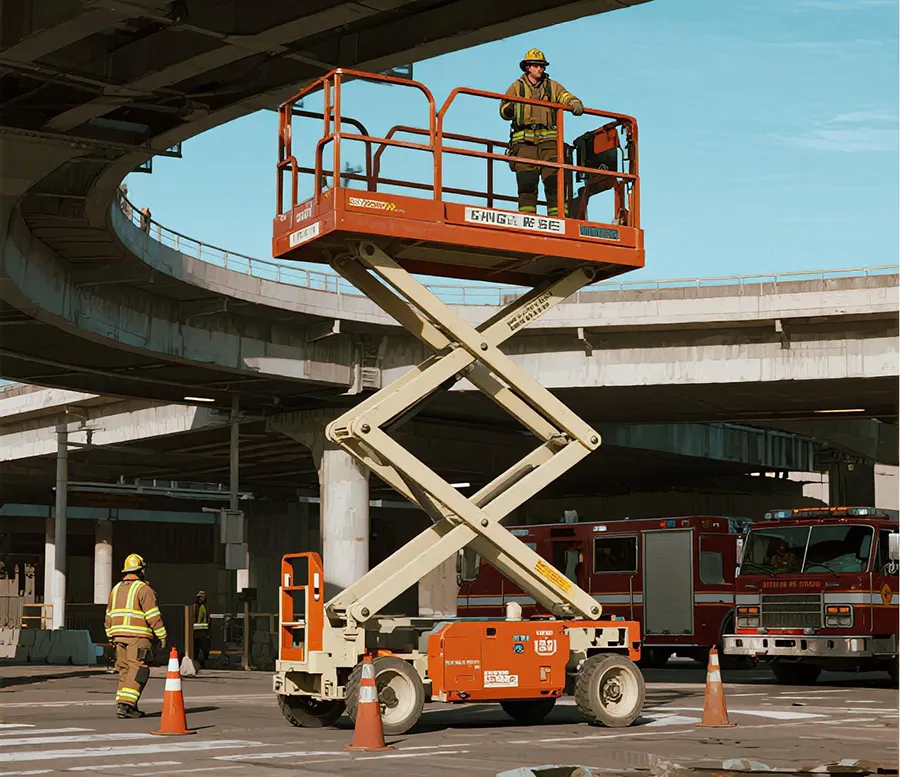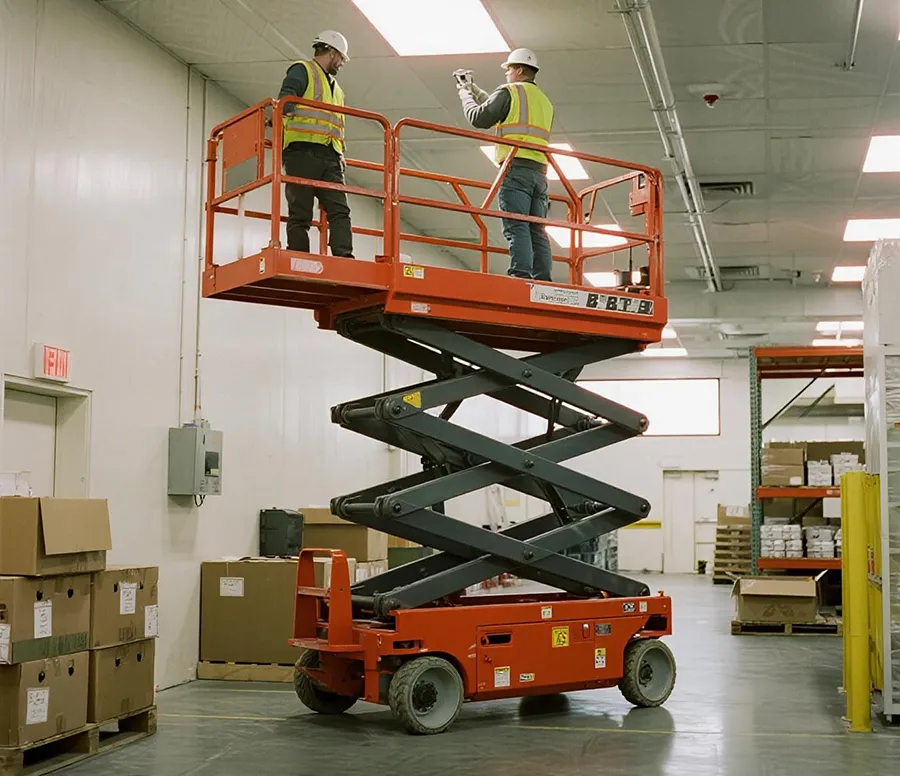This guide explores the different types of aerial work platforms, their features, and their best applications to help you have a better understanding of these machines.
Common Types of Aerial Work Platforms
Aerial work platforms can be broadly categorized into two main types based on their lifting mechanisms: scissor lifts and boom lifts.
Scissor lifts are ideal for vertical elevation applications where straight up-and-down movement is required. Boom lifts, on the other hand, are designed for operations requiring horizontal outreach, making them suitable for work environments where there’s a significant horizontal distance between the equipment position and the work surface.
1. Scissor Lift
As one of the most widely used aerial work platforms, scissor lifts are renowned for their stable mechanical structure and high load-bearing capacity, making them ideal for applications requiring multi-person simultaneous operations.
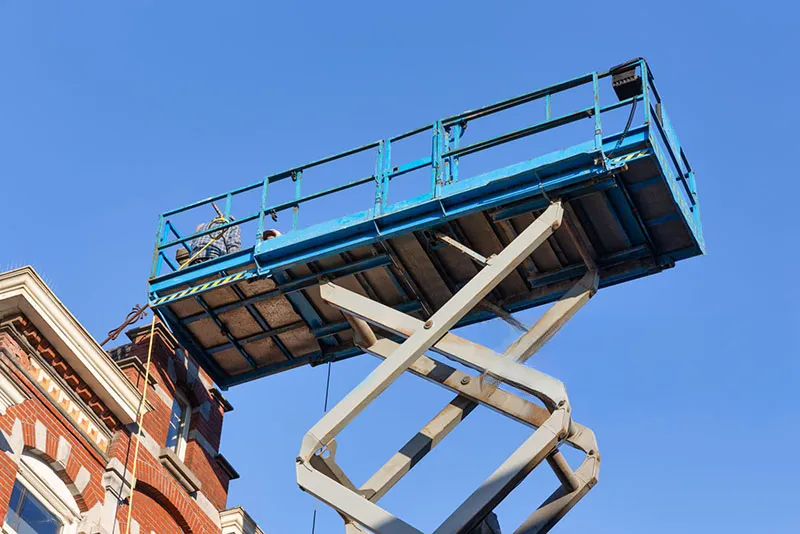
Main Function
Its primary function is vertical lifting. The operating platform is typically equipped with a slightly extendable front section that moderately expands the working range. For instance, when painting a wall without requiring frequent lateral movement, a scissor lift would be an ideal choice. However, for tasks demanding frequent horizontal repositioning, the scissor lift’s limited forward extension and inability to move sideways may prove less flexible in certain scenarios.
Design Features
The lifting mechanism employs crossed arms forming multiple parallelogram structures, achieving elevation through the folding and unfolding of these quadrilateral configurations, providing exceptional stability and load-bearing capacity. The spacious work platform and high load capacity enable it to accommodate a wider range of elevated tasks while supporting multiple operators working concurrently.
The lifting structure is typically constructed with high-strength manganese steel rectangular tubing to ensure structural robustness and durability. Additionally, the equipment incorporates multiple safety features, including overload protection devices, hydraulic circuit rupture prevention valves, and emergency descent mechanisms for power failures to ensure operational safety.
Applications
Suitable for elevated installation, maintenance, and other mobile work applications across various industries. Different models are available for both indoor and outdoor environments.
2. Boom Lift
Boom lifts can achieve extensive coverage of work surfaces with wide-angle reach while maintaining minimal base movement. These platforms are primarily categorized into two types: telescopic boom lifts and articulating boom lifts.
2.1 Telescopic Boom Lift
Telescopic boom lifts feature a linear boom structure with two or more nested boom sections that extend and retract for lifting and lowering operations. They offer higher maximum platform heights and greater horizontal outreach, providing extensive work coverage and high efficiency.
The telescopic boom enables precise vertical positioning and can overcome certain obstacles, allowing multiple work points to be accessed from a single setup. With 360-degree rotation and a large platform capacity, these lifts can accommodate two or more workers simultaneously while carrying necessary equipment. They offer excellent mobility for easy relocation between work sites and feature an aesthetically pleasing design suitable for both indoor and outdoor operations and storage.
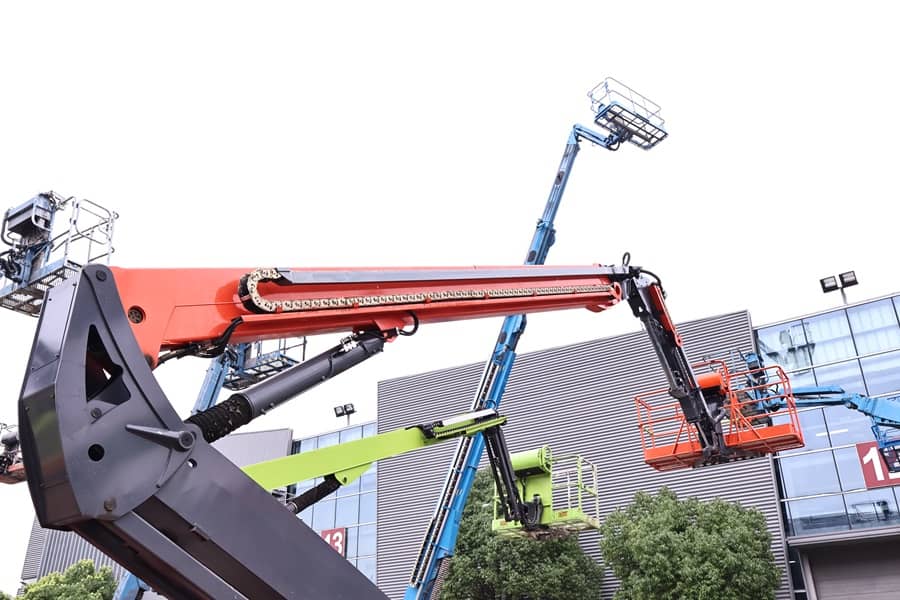
Applications
Ideal for large-scale steel structures, construction projects, the shipbuilding industry, curtain wall engineering, petrochemical facilities, and other industrial applications requiring extensive work coverage.
2.2 Articulating Boom Lift
Characterized by simple operational structure, user-friendly controls, reliable safety features, and aesthetically pleasing design, these represent the optimal combination of safety and work efficiency in aerial work platforms.
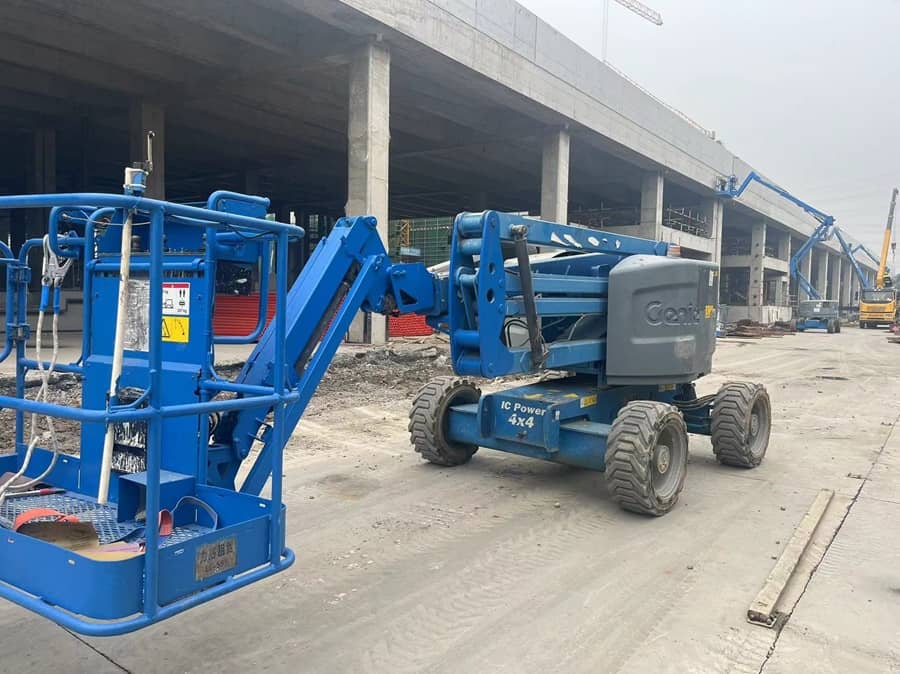
Main Function
The lifting mechanism employs a foldable boom structure, achieving elevation through extension/folding of articulated sections. This provides:
- Multi-directional positioning (upward/downward/obstacle-crossing)
- Adaptability to complex working conditions
- Safe platform movement at all boom positions
- Auto-adjusted travel speed (reduces with elevation)
- Dual control stations (ground/platform) with a selector switch
- Upper control station override/lockout capability
Applications
While similar to telescopic boom lifts in overall usage, articulating boom lifts demonstrate better performance in complex applications. Widely deployed for municipal maintenance, power/utility line work, streetlight servicing, advertising installation, telecommunications, photography, landscaping, transportation infrastructure, port/airport operations, and large industrial/mining facilities.
3. Gantry Type Aerial Work Platform
The gantry aerial work platform is a compact and lightweight elevated work equipment, typically constructed from high-strength aluminum alloy materials or high-strength C-channel steel. It offers several advantages, including an aesthetically pleasing design, small footprint, light weight, smooth lifting operation, and reliable safety features.
This equipment can perform lifting operations at considerable heights within confined spaces while maintaining mobility in the elevated position. Its intelligent control system enables all operations to be completed independently by a single operator.
Applications
Ideal for warehouse and supermarket environments where elevated access is required for goods storage and retrieval operations.
4. Vertical Mast Lift
The mast-type aerial work platform features a vertical telescoping lifting structure, characterized by its large load capacity, spacious work platform, excellent stability, and flexible mobility. It is specifically designed for elevated work performed by 1-2 operators.
Constructed primarily from high-strength aluminum alloy materials, this platform offers multiple advantages, including compact size, lightweight construction, smooth lifting operation, and reliable safety performance. Its design enables high lifting capability even within confined workspaces.
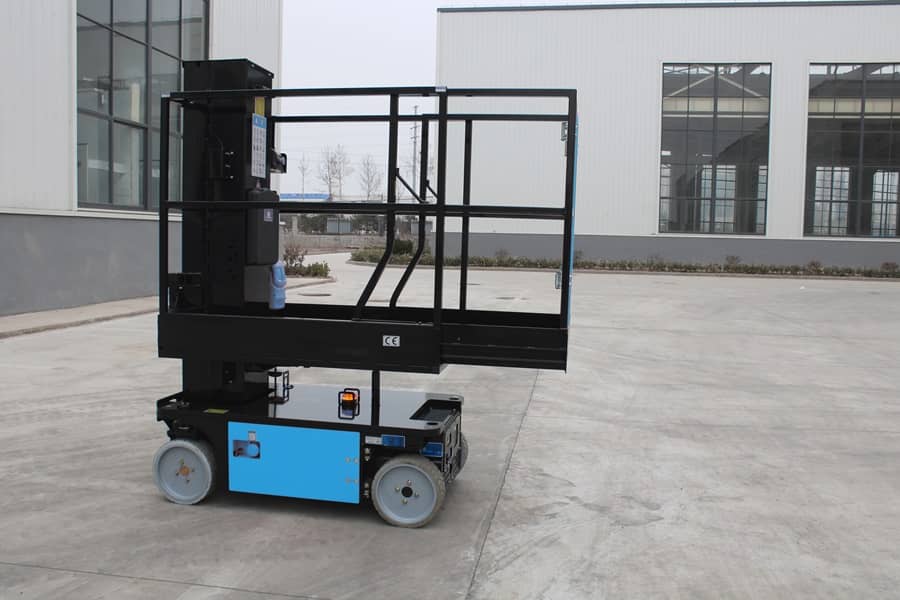
Applications
Ideal for indoor elevated work environments where space constraints exist.
Classification by Chassis Power Type
1. Vehicle-Mounted Aerial Work Platforms
Vehicle-mounted aerial work platforms are specialized equipment created by modifying vehicles with lifting mechanisms. These platforms utilize either the vehicle’s engine power or the DC power from electric battery carts to achieve lifting functions. Combining vehicle mobility with aerial work platform capabilities, they are ideal for scenarios requiring both transportation and elevated access.
Product Features
- Equipped with H-type hydraulic outriggers to ensure operational stability and safety
- Capable of using independent DC power sources to enable rotation and lifting functions
- Offers an extensive working range and prolonged operation duration, particularly suitable for field maintenance and streetlight repair
- The battery-powered, vehicle-mounted version requires no external power supply, featuring zero emissions, no exhaust fumes, a wide operational range, and excellent mobility
Applications
Field maintenance operations, streetlight maintenance and repair, tree trimming operations, cold storage facilities, high-density public areas (train stations, bus terminals, airports, etc.)
2. Self-Propelled Aerial Work Platforms
Self-propelled aerial work platforms refer to equipment with an integrated chassis power system, enabling autonomous movement without external assistance. Position control can be operated directly from the platform’s control panel, even while maintaining an elevated position.
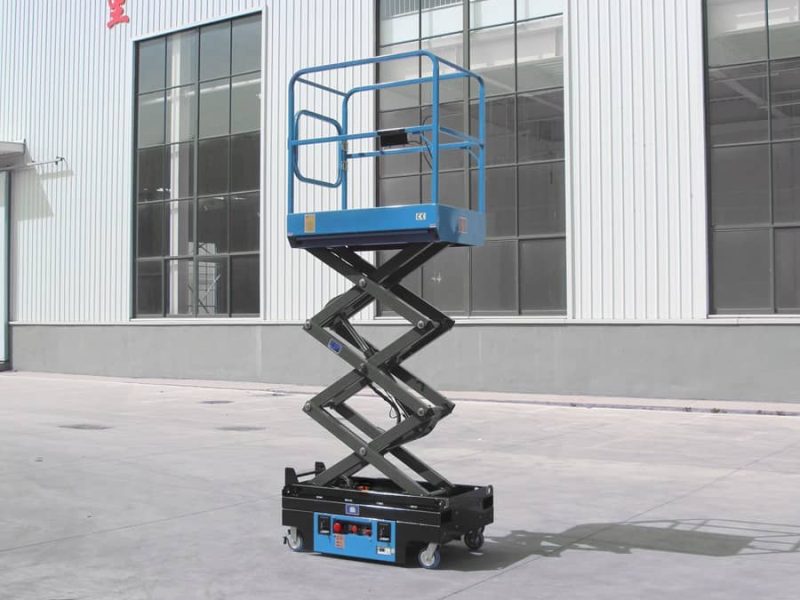
Compared to vehicle-mounted platforms, these units are more compact and maneuverable. With advancements in technology, modern self-propelled lifts increasingly utilize high-grade aluminum alloy materials, ensuring exceptionally smooth operation with minimal deflection or sway during use.
Applications
Ideal for large-area operations such as airport terminals and railway/bus stations, and other spacious work environments requiring mobile elevated access.
3. Towable Aerial Work Platforms
This type of lift typically lacks its propulsion system and requires external force (pushing or towing) for movement. This means other equipment or manual labor may be needed to relocate the lift during use. Due to their dependence on external power for transportation, they lack autonomy in mobility. Consequently, they may be less flexible than self-propelled lifts for long-distance movement or work environments requiring rapid repositioning.
Applications
Ideal for scenarios where frequent relocation isn’t necessary or where external assistance for movement is acceptable. For example, towable lifts are widely used by customers with elevated access needs in factory workshops, atriums/public squares, airports, and industrial/commercial campuses. Their cost-effectiveness and adaptability make them a practical choice for these applications.
Classification by Power Source
1. Electric-Powered Aerial Work Platforms
Electric-powered aerial work platforms utilize battery-supplied energy to drive both lifting and movement mechanisms via electric motors. These platforms typically feature zero emissions and low noise levels, making them ideal for indoor operations.
Key Features
- Eco-Friendly Operation: Oil-free and pollution-free, perfect for indoor environments.
- User-Friendly Controls: Equipped with intelligent control systems for easy, single-operator use.
- Enhanced Flexibility: Capable of chassis movement while the lifting structure remains extended, enabling multi-point operations.
- Safety Assurance: Includes multiple protective mechanisms such as overload prevention devices, hydraulic circuit rupture safety valves, and emergency descent systems for power failures.
Applications
- Indoor Construction: Low-noise, low-emission environments with high environmental standards. Tasks like indoor renovations, equipment installations, and logistics handling requiring elevated access.
- Public Spaces: Installation, maintenance, and cleaning operations in airports, train stations, shopping malls, and stadiums.
2. Engine-Powered Aerial Work Platforms
Engine-powered lifts utilize diesel or gasoline engines as their power source, employing either mechanical or hydraulic transmission systems to achieve lifting and mobility. These platforms typically deliver robust power output, making them particularly suitable for outdoor operations.
Key Features
- High Power Output: The internal combustion engine provides strong power performance, ideal for applications requiring substantial power.
- Extended Operation Time: Engine-powered platforms generally offer longer continuous operation, suitable for prolonged work sessions.
- Superior Adaptability: Capable of functioning across varied terrains and harsh environmental conditions with excellent adaptability.
- Higher Operational Costs: Typically involve greater initial investment and maintenance expenses compared to electric models.
Applications
- Rugged Outdoor Terrain: Tasks demanding enhanced driving force and traction, typically employing diesel engines (e.g., off-road conditions).
- Outdoor Maintenance Work: Including bridge maintenance, municipal landscaping, and power line servicing.
- Long-Duration Operations: Such as large-scale equipment installations or building facade cleaning projects requiring uninterrupted operation.
3. Hybrid-Powered Aerial Work Platforms
Hybrid-powered aerial work platforms combine the advantages of electric and internal combustion systems. They can activate the engine when high power output is required, while utilizing electric power for low-speed movement or operation, significantly improving energy efficiency.
Key Features
- Energy-Efficient & Eco-Friendly: The hybrid system converts energy generated during braking or downhill movement into battery charging, reducing energy consumption and environmental impact.
- Flexible Power Modes: The system seamlessly switches between power sources based on operational needs, enhancing work efficiency.
- Extended Operation Time: By combining the benefits of both electric and engine power, hybrid platforms deliver superior endurance for prolonged tasks.
- Moderate Cost: Hybrid systems offer a balanced cost between pure electric and engine-powered models, making them ideal for mid-to-high-end market demands.
Applications
- Long-Duration Operations: Such as large-scale equipment installation or building facade cleaning.
- Frequent Mode-Switching Scenarios: Including urban maintenance, power line work, streetlight servicing, and advertising installations.
Conclusion
Understanding the types of aerial work platforms helps businesses select the safest, most efficient equipment for their needs. Whether for construction, maintenance, or specialized tasks, the right AWP enhances productivity while ensuring worker safety.
Looking for the best aerial work platform? Holdwell provides both used aerial lifts and new aerial work platforms for you to choose from. Contact us today for expert recommendations!

